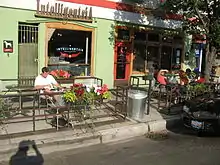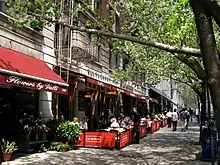Sidewalk cafe
A sidewalk cafe or pavement cafe is "a portion of an eating or drinking place, located on a public sidewalk, that provides waiter or waitress service" (as defined by the American Planning Association based upon the New York City planning regulations); the area used solely for dining.[1] Sidewalk cafes are of two types: enclosed and unenclosed, the former being surrounded by a 1-story structure and the latter being an area of the sidewalk that contains removable tables, chairs, and railings.[1]

- For the music venue in New York City, see SideWalk Cafe.
Sidewalk cafes are common across Europe, forming an important part of street life in countries such as France and Italy.[2]

New York City

New York City regulations control in what areas sidewalk cafes can exist, their construction, and what parts of a sidewalk they can occupy.[3] Proprietors pay a licence fee, which is effectively rent paid to the city for the use of the sidewalk.[4]
From 1988 these regulations were a zoning resolution of the city's Department of Planning.[3] The 1988 resolution prohibited sidewalk cafes in residential areas and on major thoroughfares, permitting them in malls and (conditionally) "in Historic Districts or in designated Landmark Buildings".[3] The stated purposes of the planning regulations are to balance the cafe proprietors' interests against the needs of pedestrians; to conserve the value of land; and to preserve the characters of neighborhoods.[3]
Until 2003 the process for obtaining a licence for a sidewalk cafe involved so many city agencies and such a long wait time that the law was regularly flouted, with restaurateurs considering it cheaper to just erect sidewalk cafes and pay the fines after the fact.[4] New approval processes were adopted in that year, shortening the process to 140 days and making it the sole responsibility of the city's Department of Consumer Affairs.[4]
The COVID-19 pandemic in New York City forced restaurants to close their dining rooms. They received emergency permission to operate al fresco dining areas in streets. By September 2020, 10,600 restaurants had enrolled in the city's outdoor dining program, compared to just 1,023 sidewalk cafes that existed before the pandemic.[5]
References
- Dolnick & Davidson 1999, p. 200.
- Hayward, Tim (6 July 2009). "Dining out, out". The Guardian.
- Gumpert & Drucker 2017, p. 445.
- Berg 2007, p. 30.
- Hu, Winnie; Schweber, Nate (2020-11-09). "The Setups for Outdoor Winter Dining Are Lavish. But Are They Safe?". The New York Times. ISSN 0362-4331. Retrieved 2020-12-04.
Sources
- Berg, Bruce F. (2007). New York City Politics: Governing Gotham. Rutgers University Press. ISBN 9780813543895.CS1 maint: ref=harv (link)
- Dolnick, Fay; Davidson, Michael, eds. (1999). "sidewalk cafe". A Glossary of zoning, development, and planning terms. American Planning Association.CS1 maint: ref=harv (link)
- Gumpert, Gary; Drucker, Susan J. (2017). "Media development and public space: the legislating of social interaction". In Ruben, Brent D. (ed.). Between Communication and Information. Routledge. ISBN 9781351294713.CS1 maint: ref=harv (link)
Further reading
- Ramati, Raquel. How to Save Your Own Street, Dolphin Books, 1981
- Brown, Carolyn (February 1980). "Sidewalk Cafes". Planning Advisory Service Memos. American Planning Association. pp. 80–2 et seq.CS1 maint: ref=harv (link)